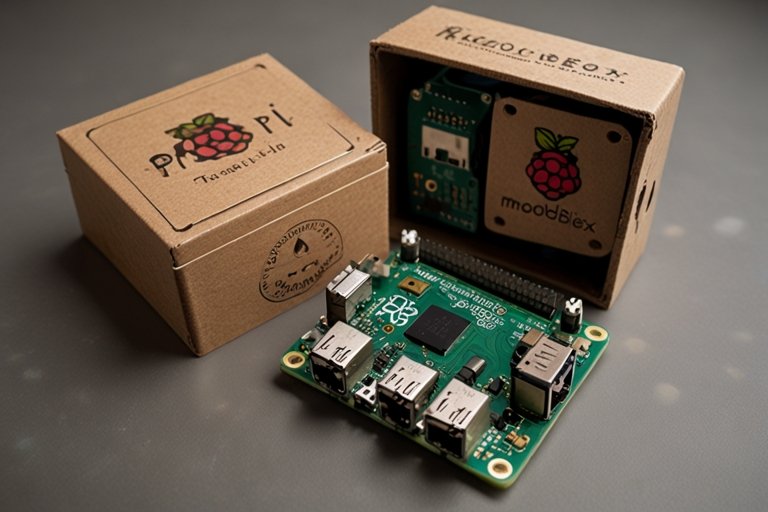Introduction
The Raspberry Pi MoodieBox represents a fascinating intersection of technology and personal wellness, utilizing the versatile Raspberry Pi platform to create a customizable device aimed at enhancing mood through sensory stimuli. This innovative project appeals to hobbyists, makers, and wellness enthusiasts alike, offering a blend of creativity and practical application in the realm of DIY electronics.
Key Components and Features
Most MoodieBox models are built around the concept of incorporating a core set of components in addition to the main Raspberry Pi SBC, namely LED light modules or strips, sound modules or speakers, and necessary sensors as needed. All these components function collectively to create a range of interfaces that allow the engagement of multiple aspects of the users to enhance mood through light, sound, and possibly other elements.
Consequently, the MoodieBox is modifiable to meet the desires and requirements of its users. Through the use of LED control, the lights can be manipulated to display flickering color sequences or soft, soothing colors depending on the user’s preference or need. Sound modules allow for playback of soft music, nature sounds, or specific music genres. This freedom enables the users to create a unique ambiance that can be used to achieve a variety of effects such as relaxation, enhanced concentration, or even improvement of mood.

Design and Construction
Assembling a Raspberry Pi MoodieBox goes through a few phases: selecting and preparing components and integrating these components into the MoodieBox. In the design preference, the user can always add a customized enclosure that will safely accommodate the Raspberry Pi board, LED lights, and sound modules. An enclosure can be as small as the owner building a box to house their device or as complex as having a specific look or feel of a printer made through 3D printing.
The assembly process normally involves soldering and installing LED strips or modules onto the enclosure, connecting the wires accordingly, and fitting sound modules or speakers in case of sound output. Pertinent disassembling instructions and tutorials can be found online and are aimed at both novices and other makers who might be interested in designing their own MoodieBox.
Programming and Customization
Programming the Raspberry Pi MoodieBox requires the advantage of the Raspberry Pi platform, such as Python programming language and GPIO (General Purpose Input Output) pins. Python scripts can also be written at the application layer to call an LED lighting sequence, synchronize the selection and playing of songs with lighting features, or interact with outside campus activity through motion or temperature sensors.
Choice is highly flexible, and users can change lighting sequences, sounds, and touch sensations to get the type of feeling that they want. Esoteric features could be MAC address pairing of the MoodieBox to the smart home systems or adding features that change functionality based on inputs or outputs.

Functional Applications
MoodieBox discover further usage in Raspberry PI, particularly in everyday settings, enhancing mood, reducing stress, and enhancing the environment. In-home use can act as an individual cheerful appliance that sets up relaxation, work urges, and exciting lighting for entertainment, among others.
In many working places like offices or those centers that deal with health and fitness like spas or gyms, MoodieBox is useful as it can help to manage the working stress by offering the staff or clients appropriate stimuli in the form of scents, lights, or music during the break time or relaxation time. Due to this, it can be recommendable for therapeutic techniques such as meditation, mindfulness sessions, or sensory integration therapies through adjusted sensory input.
Impact on Wellness and Well-being
It is important to note here that with MoodieBox, emotional state, and environmental conditions can be controlled with the help of the Raspberry Pi MoodieBox. First, MoodieBox shows how people can have control over their sensory environment, which makes individuals feel more in control of their space and be in a relaxed mood when they are in it.
Research indicates that individualized perceived stimuli can help frontal posts change different emotional states, stress, and global psychological well-being. Lighting, sound, and all the sensory stimulations involved in the MoodieBox help to manage stress and improve focus and overall well-being and should, therefore, be embraced as a tool for self-care.

Future Developments and Community Engagement
Due to constantly enhancing technology and increasing users’ interest, the Raspberry Pi MoodieBox is developed further in cooperation with people and end users. Further improvements may comprise better compatibility with IoT devices, increased capabilities of sensors, or enhancements of programming interfaces that make customization and use easier.
Additional social activities, such as forums, tutorials, and group projects, enhance the MoodieBox utility, enabling users to post questions or ideas, report problems, or find inspiration. Such a joint effort not only improves the applicability of MoodieBoxes themselves but also supports the wider community of DIY electronics and wellness solutions.
Conclusion
Therefore, Raspberry Pi MoodieBox is a perfect example of how DIY electronics can change and improve people’s lives, starting with feelings of quality and encompassing the culture of home atmosphere improvement. Thanks to the Raspberry Pi technology, modifiable parts, and programmable functions, users can design and develop their audio and video systems according to their mood and environment.
In this paper, its general framework, the process of its assembly, the complexities of programming, the possibilities of its use, and its relation to the subjective well-being of users have been discussed to evidence how the MoodieBox project reflects and embodies creativity. Regardless of the purpose – leisure, performance improvement, or healing – MoodieBox proves that technology can change the mood and generate favorable sensory settings for a person.
Ongoing research and development in the DIY electronics field guarantee that the Raspberry Pi MoodieBox will remain an active project that can grow and expand without limit in various environments. While people are encouraged to create their happy gadgets, MoodieBox serves as a perfect proxy for how science, art, and personality interact to improve the quality of life.
Frequently Asked Questions (FAQs) about Raspberry Pi MoodieBox
1. What is a Raspberry Pi MoodieBox? The Raspberry Pi MoodieBox is a DIY project that combines a Raspberry Pi single-board computer with LED lights, sound modules, and sensors to create a customizable device aimed at enhancing mood through sensory stimuli.
2. What components are typically used in a MoodieBox? A MoodieBox normally includes a Raspberry Pi board, LED light modules or strips, sound modules or speakers, and optional sensors such as motion sensors or temperature sensors, depending on the desired functionality.
3. How can I build my own Raspberry Pi MoodieBox? Building a MoodieBox involves selecting and assembling the components, mounting them within a custom enclosure or case, wiring them to the Raspberry Pi board, and programming the device using Python scripts to control lighting, sound, and sensory interactions.
4. What programming language is used for the Raspberry Pi MoodieBox? Python is commonly used to program the Raspberry Pi MoodieBox due to its ease of use and extensive support within the Raspberry Pi community. Python scripts can control LED lighting sequences, synchronize audio playback, and integrate sensor inputs.
5. Can the Raspberry Pi MoodieBox be customized? Yes, one of the key features of the MoodieBox is its customizability. Users can modify lighting patterns, adjust soundscapes, and integrate additional sensors or functionalities to suit their personal preferences and specific applications.
6. What are the practical applications of the Raspberry Pi MoodieBox? The MoodieBox can be used in various settings, including homes, offices, wellness centers, and therapeutic environments. It can enhance relaxation, promote concentration, support meditation practices, or create a dynamic ambiance for entertainment purposes.
7. Is the Raspberry Pi MoodieBox difficult to assemble for beginners? The assembly process of the MoodieBox is accessible to beginners with basic electronics knowledge. Detailed assembly instructions and tutorials are available online, guiding users through each step of the building process.
8. How does the Raspberry Pi MoodieBox influence mood and well-being? By providing customizable sensory experiences such as ambient lighting and soothing sounds, the MoodieBox can positively impact mood states, reduce stress levels, and enhance emotional well-being through personalized environmental stimuli.
9. Are there community resources or forums for Raspberry Pi MoodieBox enthusiasts? Yes, the Raspberry Pi community and various online forums offer resources, tutorials, and opportunities for collaboration among MoodieBox enthusiasts. These platforms facilitate sharing of ideas, troubleshooting, and development of new features or applications.
10. Can the Raspberry Pi MoodieBox be integrated with other smart home devices? Yes, advanced users can explore integrating MoodieBox with other IoT (Internet of Things) devices or smart home systems to enhance its functionality. This integration can expand its capabilities and interoperability within a smart home environment.





